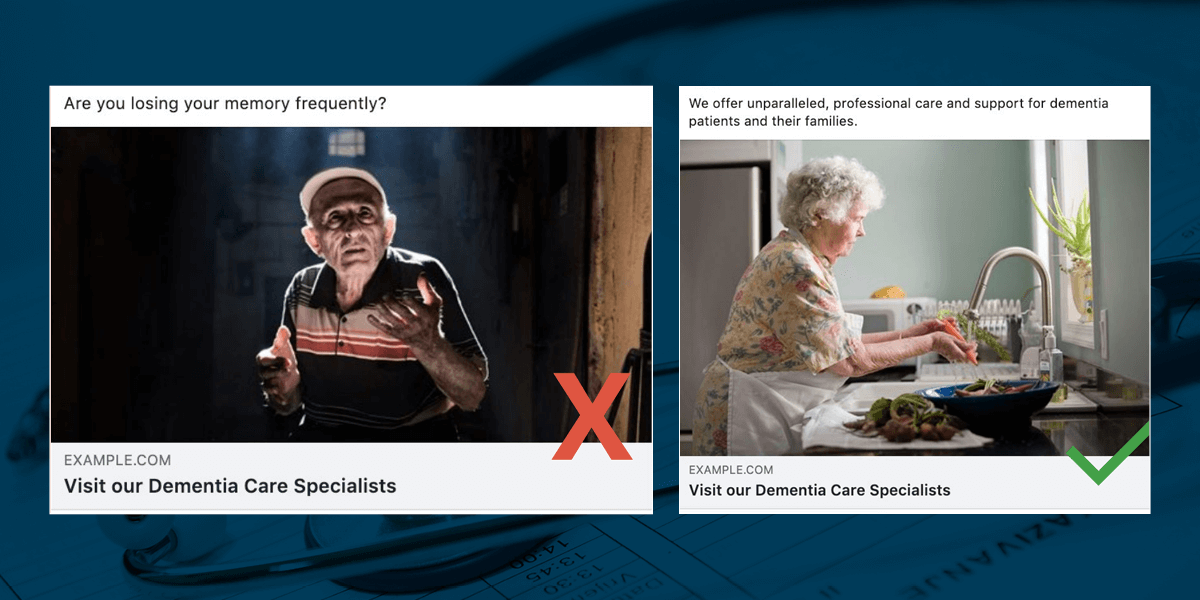
Targeting Tips for Healthcare Facebook Ads
Today’s healthcare journey begins online. Optometrists, orthodontists, therapists, and more can reach their current and future patients with digital ads on Facebook.
Facebook provides a plethora of digital advertising targeting options for advertisers to connect with a qualified audience. However, throw HIPPAA compliance and Facebook’s “personal attributes” policies into the mix, and ad targeting for healthcare marketers can feel overwhelming.
Where do I begin? What’s most effective? How do I maintain compliance?
If you’re a healthcare marketer asking these questions, don’t throw your hands up yet. Our Facebook targeting tips will help you create a strategic and effective digital advertising strategy for your healthcare practice.
1. Follow the Funnel
Every marketing tactic you employ should have a specific place in the sales funnel, which applies to healthcare, too!
- Awareness: Sometimes referred to as “top of the funnel,” these campaigns are targeted to a broad audience in order to generate interest in your services and/or make people aware that your practice exists.
- Consideration: Often referred to as “middle of the funnel,” these campaigns get people to start thinking about your practice and look for more information about it.
- Conversion: These “bottom of the funnel” campaigns encourage people interested in your services to take an action, such as scheduling an appointment.
Before you even begin creating a Facebook ad, decide which area of your sales funnel it is intended to reach. How will this campaign guide the buyer’s journey and help you prove ROI?
These questions will help you choose which campaign objectives, audiences, formats, placements, and content to use.
2. Match Your Services to Known Demographics
You know which services your practice offers, and you know the patients who are most likely to need them. With Facebook’s demographic targeting options, you can place your ads in front of the population that is most likely to respond. This can include:
Age
Are most of your services used by an older population? Or, perhaps your target audience includes parents of young children, typically around 25-35 years of age. Targeting by age can help narrow down your digital ad audience to more relevant users.
Life Stage or Event
Similarly, you can target groups based on a life stage or recent life event. For example, Facebook provides targeting options for “parents with early school-age children.”
Looking to grow your practice’s brand awareness? Consider targeting a branding campaign to people living in your area who have “recently moved.”
Another example is to target based on relationship status. A couples therapist might advertise his services and resources to individuals listed as being “in a relationship, “married,” or “engaged” on Facebook.

Exclusions
Just as important as including certain demographics in your healthcare advertising is to exclude some demographics. By excluding irrelevant or unengaged age groups, lifestyles, or interests, you’ll rest easy knowing that Facebook won’t display your ads to an unqualified audience — which is a potential waste of your advertising budget.
3. Utilize Web Traffic and Lookalike Audiences
Due to HIPAA regulations, most healthcare advertisers cannot upload patient lists to use for Facebook ad targeting.
However, you can utilize custom audiences based on people who have engaged with your other ads or posts or have visited your website. By placing the Facebook Pixel on your website, you can capture some website traffic — to either the entire site or specific web pages — and retarget those visitors.
Even better, you can use that website traffic to create a lookalike audience. This type of audience allows Facebook to create an audience that is similar to the original in demographics and website behavior.
Lookalike audiences are a strong tactic to use for “awareness” or “consideration” campaigns, while direct retargeting is strategic for “conversion” campaigns.
4. Mind Your Placements
When selecting your targeting options, you’ll also select placement preferences for your healthcare Facebook ads.
Keep in mind that ads might look differently on some placements vs. others. You’ll want to tailor your ads to the platform on while they’ll be seen and make sure they look good on each.
If you find that certain placements aren’t returning strong results for your campaigns, you can exclude those placements.

5. Follow Facebook’s Policies
This is where healthcare advertising can get a bit hairy on Facebook, but as long as you know the rules, you can play the game.
Facebook has many advertising policies regarding personal attributes, and healthcare advertisers must be aware of them. If an ad violates policy, Facebook will reject the ad, and it won’t run.
Ads must not contain content that asserts or implies personal attributes. This includes direct or indirect assertions or implications about a person’s race, ethnic origin, religion, beliefs, age, sexual orientation or practices, gender identity, disability, medical condition (including physical or mental health), financial status, membership in a trade union, criminal record, or name.
– Facebook Advertising Policies
The easiest rule of thumb is to avoid using words like “you” or “other” in your healthcare ads. For example, your ad creative can say, “Thousands trust our skin care treatment,” but it can’t say, “Do you have an embarrassing skin rash?” or “Other people with skin problems choose our products.”

If Your Ad Is Rejected
Facebook will communicate ad rejection via an alert in Ads Manager and an email. If Facebook deems your ad in violation of their policy, you can edit your ad to comply.
The ad review process is automated, so sometimes ads are incorrectly rejected. If you are confident that your healthcare Facebook ad follows policy, you can request a review of the decision. Learn more about Facebook’s policies here.
6. Test and Optimize
When it comes to your health practice’s Facebook campaigns, don’t just “set it and forget it.” Instead, experiment with different targeting strategies and measure the results to see which performs best.
Remember, testing also goes beyond the ad itself. In addition to measuring the performance within Ads Manager, keep an eye on your Google Analytics results and goals, evaluating metrics like bounce rate, session duration, and conversion events from various audiences.
Small adjustments and tests on your targeting can make a big impact on how you optimize your practice’s campaigns over time.
Reach Your Potential Patients With Facebook Ads
At 9 Clouds, we thrive off helping healthcare marketers reach the right audience at the right time with the right content.
9 Clouds has helped a variety of healthcare organizations to stand out online.
grow your practice with 9 clouds »




